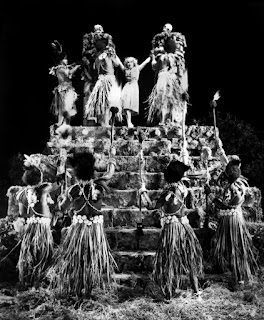 |
| Fig. 1 Poster |
 |
| Fig. 2 Kong and Ann |
It takes a while to
get used to the mechanical movements and strange nature of the Kong model but
after a small time the character becomes more believable and the viewer can
sink further into the story. Far fewer
people had seen a real gorilla move at the time of the film's release and so it
would have been easier for viewers in 1933 to come to believe the special
effects. The stop motion monsters in this film will have seemed more real than
anything seen in film before, stunning audiences and creating a massive impact
in cinema. The brilliant visual effects of the film seem to have been the main
focus of the film by a very long way, at the time it was said that 'Neither the story nor the cast gains more than secondary importance, and not even close. Technical aspects are always on top'. (Bigelow, 1933).
 |
| Fig. 3 Ann, captured by the natives of Skull Island |
'King Kong' is a
product of its time, the film has a very insensitive representation of
minorities and it objectifies women. The natives of Skull Island are depicted
as unintelligent and savage and there are parallels between Kong's capture and
slavery, as he is taken from his home world and displayed for the entertainment
of white people. Fatimah Tobing Rony writes that 'The Lineage of King Kong should be obvious: the filming, capture, exhibition, photographing, and finally murder of Kong takes its cue from the historic exploitation of native peoples as freakish "ethnographic" specimens by science, cinema and popular culture.'
(Rony, 1996:159). In addition, Fay Wray's character Ann Darrow is depicted as frail
and silly and the men are often shown insulting her, including the man she
falls in love with. This film adhered to and likely helped cement the Hollywood
format that continued for a very long time and still lingers: tall, unworthy
white man rescues pathetic, dainty white lady from huge black brute - or some
other nasty racial stereotype.
 |
| Fig. 4 Kong displayed in New York |
The film does have
fantastic action scenes; the fight between Kong and the dinosaur as Ann sits
trapped on a massive tree is very impressive in a variety of ways. The mastery
of the models is apparent in this scene and the stop motion animation is masterful,
many technical aspects shine in this scene. It also creates a good feeling of
suspense, as the viewer is beginning to become attached to Kong, and Ann sits in a very precarious position as the fight carries on around her. Roger Ebert writes that O'Brien's work in
this film had 'a sophistication and beauty that eclipsed anything that went before.' (Ebert, 2002).
 |
| Fig. 5 Kong battles a dinosaur |
The musical score is
also very important, both in its excellence at enhancing the visuals and story
of the film and in the effect it had on the future of music in cinema. 'Max Steiner's music adds fantastic atmosphere (it also helped lay down some of the basic rules of motion pictures scoring).' (Haflidason, 2001).
Sound in feature film was still a recent development when 'King Kong' was made,
so there was room for exploration. Though Max Steiner took influence from Richard
Wagner in his method of assigning a theme for each character, the musical score
for Kong was revolutionary in cinema and it has massively influenced the film industry. The music was described as 'gripping and fitting' (Bigelow, 1933) at that still holds true today.
Bibliography
Bigelow, J. (1933) Review: King Kong. At: http://variety.com/1933/film/reviews/king-kong-2-1200410783/ (Accessed on 08.10.16)
Ebert, R. (2002) Great Movie King Kong. At: http://www.rogerebert.com/reviews/great-movie-king-kong-1933 (Accessed on 08.10.16)
Haflidason, A. (2001). King Kong (1933) At: http://www.bbc.co.uk/films/2001/01/30/king_kong_1933_review.shtml (Accessed on 08.10.16)
Rony, F. (1996) The Third Eye: Race, Cinema, and Ethnographic Spectacle. [Online] At: https://books.google.co.uk/books?id=ZFZTUSikmFkC&printsec=frontcover&dq=The+Third+Eye:+Race,+Cinema,+and+Ethnographic+Spectacle&hl=en&sa=X&ved=0ahUKEwiAoufD4MvPAhVE1xoKHdBxCSEQ6AEIHDAA#v=onepage&q&f=false (Accessed on 08.10.16)
Illustrations
Fig. 1 Poster
Cooper, M and Schoedsack, E. (1933). 'King Kong'. [Poster] At: https://upload.wikimedia.org/wikipedia/commons/f/f3/Kingkongposter.jpg (Accessed on 08.10.16)
Fig. 2 Kong and Ann
Cooper, M and Schoedsack, E. (1933). 'King Kong'. [Film Still] At: http://www.shillpages.com/faywray/wrayfp35.jpg (Accessed on 08.10.16)
Fig. 3 Ann captured by the natives of Skull Island
Cooper, M and Schoedsack, E. (1933). 'King Kong'. [Film Still] At: https://images-na.ssl-images-amazon.com/images/M/MV5BMTc1MzU1MzQxM15BMl5BanBnXkFtZTgwMTYzMzU5MTE@._V1_.jpg (Accessed on 08.10.16)
Fig. 4 Kong displayed in New York
Cooper, M and Schoedsack, E. (1933). 'King Kong'. [Film Still] At: http://manapop.com/wp-content/uploads/2015/07/kong-on-stage.jpg (Accessed on 08.10.16)
Fig. 5 Kong battles a dinosaur
Cooper, M and Schoedsack, E. (1933). 'King Kong'. [Film Still] At: http://room226.weebly.com/uploads/5/3/4/4/5344580/6639772_orig.jpg?317 (Accessed on 08.10.16)

Excellent, Ellie! Well contextualised and a sensible use of supporting quotes :)
ReplyDeleteIf you are mentioning other films, you should always include the year after the name, in barckets. So 'Jurassic Park' (1993)for example. The film name is in italics, as you have done...but it's not possible to write in italics in the comments :(
Thank you, Jackie :)
DeleteI'll do my best to remember to include the date in future.